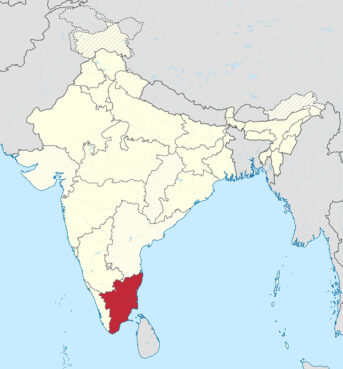(RNS) — When coconut farmers in India’s Tamil Nadu state stumbled throughout a stone lined in unusual inscriptions, it’s unlikely they anticipated it to be a groundbreaking discover in Indian Jewish historical past.
Nevertheless, the stone — a tombstone with Hebrew writing — has been recognized as one of many oldest Jewish artifacts in India and has opened a window right into a beforehand unknown neighborhood.
“This discovery is likely to be resulting in a brand new chapter,” Thoufeek Zakriya, a Hebrew calligrapher and scholar of Indian Jewish historical past who translated the stone, advised RNS.
In relation to Jewish historical past in India, there are a number of communities normally mentioned.
The oldest are the Cochin Jews of Kerala on southwest India’s Malabar coast. To the north is the Bene Israel neighborhood, which was centered round Mumbai and different cities of the subcontinent’s northwest, so far as Karachi in Pakistan. Within the northeastern Manipur state are the Bene Menashe. Over the centuries, service provider communities of Baghdadi and Sephardic Jews would settle within the subcontinent’s main ports and buying and selling facilities. The Sephardic communities grew to become collectively referred to as Paradesi — which means overseas — Jews. The overwhelming majority of India’s Jews have migrated to Israel within the many years for the reason that institution of the Jewish state. At the moment, greater than 70,000 Indian Jews reside in Israel, whereas fewer than 5,000 stay in India.

The state of Tamil Nadu, pink, in southern India. (Picture courtesy Wikimedia/Artistic Commons)
Traditionally, in Tamil Nadu, there was a Paradesi Jewish neighborhood centered round Chennai — then referred to as Madras.
The tombstone, nonetheless, was discovered greater than 200 miles to the south in Ramanathapuram, a metropolis in southeastern India on a peninsula that juts out towards Sri Lanka. Beforehand, there had been no communal reminiscence of a Jewish neighborhood in that a part of India and scant archaeological hints.
The demise date on the stone, which locations it within the thirteenth century, reveals that it predates the Madras neighborhood by a number of centuries.
Communal lore tells that the Cochin Jews of Kerala arrived on the subcontinent within the fifth century BCE, following the destruction of Solomon’s temple and the Babylonian Exile. Christians in the identical area hint their origin to Jesus’ disciple St. Thomas, claiming he traveled to India to unfold the gospel within the 1st century CE.
Nevertheless, the oldest Jewish tombstone within the nation, the Sara Bat Israel Tombstone, is dated to 1269 CE. The stone found in Ramanathapuram is sort of half a century older, dated to between 1224 and 1226 CE.
Zakriya defined that the stone is now the third and most conclusive piece of proof of a Jewish presence within the space. The primary was one other tombstone found within the Forties, however the date on it was by no means recorded, and the artifact itself has been misplaced within the many years since India’s independence. Solely analysis notes stay. It’s potential it was from the identical interval.

The newly found tombstone is now regarded as the oldest Jewish artifact in India. (Photograph courtesy Thoufeek Zakriya)
Regardless of containing solely a few dozen phrases, the stone’s inscription nonetheless provides perception into the character of the neighborhood, particularly its ties with Yemenite Jewry.
The date on the stone (2335) is just not written within the Hebrew calendar (which might have been 5784) utilized by most Jewish communities right now however somewhat in a system referred to as the Seleucid Period, which, as a substitute of starting with Genesis’ account of the creation of the world, started with the conquest of Babylon by Alexander the Nice’s common, Seleucus I Nicator.
The Seleucid Period system was as soon as commonplace throughout the Close to East however is right now used solely by the Yemenite Jewish neighborhood as a authorized calendar, known as “Minyan Shtarot,” which means the Period of Contracts.
Zakriya famous that different facets of the Hebrew lettering inscribed on the stone are just like examples present in Yemen and Yemenite communities. He believes the stone may point out a colony of Yemenite Jews had as soon as lived close to Ramanathapuram, or no less than that the neighborhood had an in depth reference to the Arab retailers, together with Yemenite Jews, that had been commonplace throughout India’s Malabar coast the place Cochin is and Ma’bar coast the place Ramanathapuram sits.
The stone may have been solely misplaced had been it not for a good friend of Zakriya’s who acknowledged that the characters could also be Hebrew and despatched information in regards to the discovering to Zakriya who right now lives within the United Arab Emirates.

Thoufeek Zakriya. (Photograph courtesy Thoufeek Zakriya)
Zakriya grew up in southern India and speaks each Hebrew and the native Tamil language. Although a Muslim, an encounter with Indian Jews in Cochin’s historic Jew City as a young person set off a lifelong curiosity in Hebrew and in India’s Jewish historical past.
The stone itself is just not one hundred pc conclusive proof of a neighborhood in Ramanathapuram, however Zakriye hopes it’ll spark additional investigation of the realm.
“If it was only one stone, perhaps some individuals may say it’s simply been relocated, however now it’s two stones, the second Hebrew inscription and the third Jewish inscription within the space” Zakriya stated.
“For something and the whole lot, there can be a child step, a begin, just like the tip of the iceberg,” he added.












